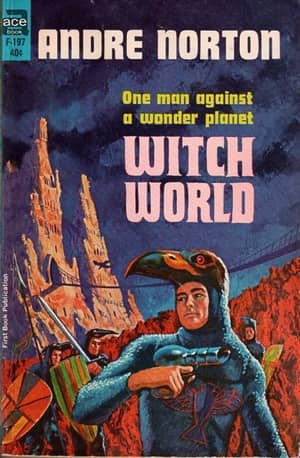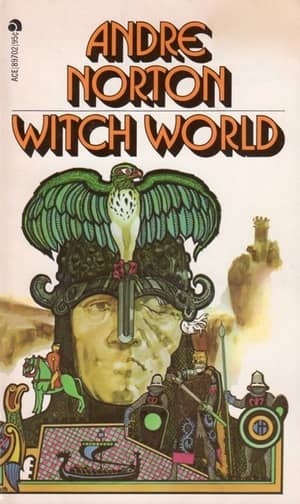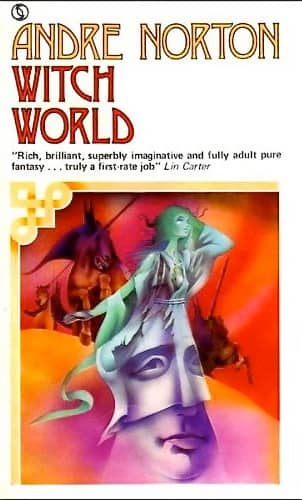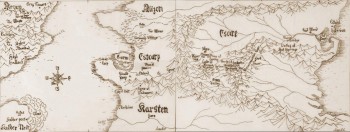Witch World by Andre Norton
 This isn’t merely an excercise in cross-promotion (it is that, just not only that), but also a chance to redress a failing in my reviews of Andre Norton’s Witch World books. Neither here at Black Gate nor back at my own site, Stuff I Like, have I ever actually written about the first book in the series, Witch World. Now that I’m a “special guest” on the just released episode of the Appendix N Book Club podcast about the book, I believe I have a responsibility to write it up, too.
This isn’t merely an excercise in cross-promotion (it is that, just not only that), but also a chance to redress a failing in my reviews of Andre Norton’s Witch World books. Neither here at Black Gate nor back at my own site, Stuff I Like, have I ever actually written about the first book in the series, Witch World. Now that I’m a “special guest” on the just released episode of the Appendix N Book Club podcast about the book, I believe I have a responsibility to write it up, too.
I’ve written a fair amount about Andre Norton’s classic Witch World series over the past six years. So far, I’ve read five of the Estcarp books, two of the High Hallack books, and two collections of short stories. While several of the books are less than stellar, overall the series is terrific.
Sadly, instead of being one of the salient series from sword & sorcery of the 1960s and 70s, it’s a half-forgotten afterthought. While I want to say that that’s a savage indictment of the nature of contemporary readers, really it’s the lamentable reality of the fate of the vast sum of popular fiction, no matter how objectively good it is or how much we love it. All a fan can do is put it out there that these are good books, still worth reading, and hope for the best.
Born in 1912, Alice Mary Norton worked as a teacher, a librarian, and finally a reader for Gnome Press before becoming a full-time writer in 1958. By then she’d already had a dozen books published, including such classics as Star Man’s Son, 2250 A.D. and Star Rangers. Based on their easy style and simpler characterizations, most of her early books would probably be classified as YA today. It was with 1963’s Witch World that Norton first wrote a full-fledged sword & sorcery book, steeped in pulp gloriousness.
The opening of Witch World is straight out of a Third Man-style film noir. Some years after the close of WWII, Simon Tregarth is a disgraced ex-US Army Lieutenant Colonel and desperate black marketeer on the run from his own associates. He’s just killed two of them, but the worst and most dangerous is still hunting for him.
Only the intervention of the mysterious Dr. Jorge Petronius offers him a chance of survival. For a price, Petronius will bring the renegade to the Siege Perilous. In Arthurian legends, the Siege was a chair at the round table reserverd for the knight who completed the Grail quest, but for anyone else, it brought instant death. In this book it is a seat that will allow a person to pass on to the place his soul has always yearned for.
“I know that Sacarsi and Wolverstein haven’t been heard of since they contacted you,” he conceded.
“No, for they went through their doors; they found the worlds they had always unconsciously sought. It is as I have told you. One takes his seat upon the Siege and before him opens that existence in which his spirit, his mind—his soul if you wish to call it that—is at home. And he goes forth to seek his fortune there.”
 Sitting upon the Siege, Simon is drawn into a world of magic and superscience. In the very moment of his arrival he sees a woman, clothes tattered and torn, being hunted down by a band of mounted soldiers and monstrous hounds. With a few well-aimed shots from his pistol they are able temporarily evade her pursuers and take refuge in a cliffside cave. It isn’t Simon who defeats her enemies, but herself.
Sitting upon the Siege, Simon is drawn into a world of magic and superscience. In the very moment of his arrival he sees a woman, clothes tattered and torn, being hunted down by a band of mounted soldiers and monstrous hounds. With a few well-aimed shots from his pistol they are able temporarily evade her pursuers and take refuge in a cliffside cave. It isn’t Simon who defeats her enemies, but herself.
What followed Simon did not understand, but he had sense enough not to interfere. The cloudy crystal strapped to her wrist gave off a faint graveside radiance. By that he watched the point of the knife stab into the ball of her thumb. A drop of blood gathered on the skin, was rubbed across the crystal, so for a moment the thick liquid obscured the scrap of light.
Then up from that oval shone a brighter glow, a shaft of flame. Again his companion laughed, the low chuckle of satisfaction. Within seconds the crystal was dim once again. She laid her hand across his gun and he read in that gesture another message. The weapon was no longer necessary, aid would come.
The swampland wind with its puffs of rottenness moaned around and between the tongues of rock. She was shivering again and he put his arm about her hunched shoulders drawing her to him so that the warmth of their bodies could be joined. Along the arch of the sky flashed a jagged sword of purple lightning.
Many more flashes of lightning come and they destroy the riders and their dogs. They are left little more than a heap of tangled limbs enveloped by the scent of burned meat.
Simon has been transported to the land of Estcarp just as it is about to enter its time of greatest crisis. The soldiers chasing the woman were from the brutal northern kingdom of Alizon. To the south lies the thuggish land of Karsten. Out on the ocean in the west, strange invaders called the Kolder have destroyed Estcarp’s ally, Gorm. All three now threaten Estcarp with destruction.
Estcarp is a matriarchate and is ruled by a council of witches. On the Witch World, only women of the old high race have are known to have the Power. Not all women have the Power, but only women have it. To give up one’s name is to give up a piece of oneself, so the woman Simon helped remains nameless to him. Also, any who have sex lose their abilities.
For the Power, for being women who rule over men, the Alizonites and Karsteners hate them. What animus the Kolder hold, no one knows. Every spy sent into their domain has vanished and never been heard from again.
 Simon learns the lay of the land as well as the language, and chooses a side — Estcarp. The matriarchate seems benign, the other nations wicked at best, and he is definitely smitten with the witch he helped. He enlists in the Estcarp Guard. Alongside Koris, the Guard’s commander, a misshapen exile from Gorm, Simon is thrown into great danger almost at once.
Simon learns the lay of the land as well as the language, and chooses a side — Estcarp. The matriarchate seems benign, the other nations wicked at best, and he is definitely smitten with the witch he helped. He enlists in the Estcarp Guard. Alongside Koris, the Guard’s commander, a misshapen exile from Gorm, Simon is thrown into great danger almost at once.
As the alien power of the Kolder begins to infect more of the world, events move with increasing momentum. A military mission to help defend Sulcarkeep, one of Estcarp’s few allies, ends in disaster and destruction. Before the book’s final chapter, the forces of Estcarp will face terrible dangers, suffer more defeats, find new recruits, and uncover the answers to strange mysteries.
At its heart, Witch World is pure pulp adventure. It moves from one episode of action or suspense to another with barely a breath between them. The paperback version is just over 200 pages and there’s not a wasted one there. Norton’s prose may be low key, but the world she created with it is exotic and colorful. Any medievalisms are smothered in superscience and the unique societies of the Witch World.
Mentioning superscience, I need to point out that the book is from the time before the distinct separation of sci-fi and fantasy we live in today. Swords and axes — a big, bad magic one — beside dart guns and explosives, it’s all good. Flying machines and horses in the same book, that’s just fine. Magic and psi-powers, that’s cool too.
The lead hero and heroine are bold and beautiful, daring and charismatic. Both willingly place themselves in grave danger for the benefit of others. Unlike the dithering or cynical stars of too many contemporary books, Simon Tregarth and the nameless witch (and if that bothers you, we do learn it in the end) are true heroes.
If that’s all Witch World was, you’d still have every reason to read it. It’s not just that, though. In his review of Witch World, Matthew David Surridge called it a transitional work for the genre. I agree with that assessment. Though they never become overwhelming, or even delved into too deeply, the book is packed with themes more mature than customary to previous S&S. There’s rape, ethnic cleansing, torture, and other difficult subject matter.
There’s also something Norton would address many more times in later Witch World stories: the place of women in pre-industrial societies. Where strength is the determinant of power, Norton makes clear that women will often be at the mercy of men. Finding some sort of independence takes real acts of courage and determination.
In Witch World, we see this through the eyes of Loyse, the plain-looking daughter of a brigandish lord. Loyse has been promised in marriage to Karsten’s ruling duke. She wants no part of this, and in order to escape she must take incredible risks. Norton makes her transformation from ill-treated wallflower to daring escapee believable and thrilling. It also explores the precariousness of a high-status woman who has no value beyond that of an alliance prize.
Without giving up the adventure and dash of true sword & sorcery, Norton wrote fantasy that was willing to include something else. What makes this aspect of Witch World successful is the restraint with which she did this. The rape, the killing, these are things that happen in the world, but they are not what Norton is writing about. She’s not making a point that the world is a horrible place, just that some horrible things happen in it. She’s still telling an adventure story, but it’s in a world a little bit darker and a little bit truer.

In the podcast (I mentioned I’m a guest on a podcast, right?), I said Witch World felt like Norton wrote it in one greast spasm of writing. It’s as if she had a ton of images and ideas she wanted to get down on paper before they became lost. There’s a feverishness to the speed at which the book moves, and lots of things — big, often explosive, things — happen. There are so many, many ideas unleashed in this short book that a dozen more could be spun from them, and spin she does. Some of the later books, particularly the short story collections, are better written and more coherent than Witch World, but this is where you need to start. This is where a truly great series begins.
You can read my reviews of other Witch World books at the following links:
Musings on a Witch World and What Survives
Fletcher Vredenburgh reviews here at Black Gate most Tuesday mornings and at his own site, Stuff I Like when his muse hits him. Right now, he’s writing about nothing in particular, but he might be writing about swords & sorcery again any day now.
I’m a bigger fan of her SF, but I’ve read the first 6 or 7 “Witch World” books and loved ’em all. I much prefer the old Ace F-197 cover (the one I own) to the later ones. Right now I’m reading “Horn Crown,” a book in the High Hallack cycle. Terrific piece here, Fletcher!
I admit with some shame that I have never read WITCH WORLD, despite it having been nominated for a Hugo.
I generally enjoy Norton’s work, so I really must address this lacuna in my reading.
(Nitpick — I always heard that Norton’s birth name was “Alice Mary”, not “Mary Alice”. She actually changed her name legally to “Andre Alice Norton” fairly early in her writing career, so in a sense it is not a pseudonym.)
@smitty – Thankx! I need to read her sci-fi. For some reason, it slipped past me in my childhood. I want to read more of the High Hallack books soon.
@Rich – regarding her name, you are correct. my fault for writing without adequate proofing on my part. Gonna go fix it now.
Great Post!
I found that podcast fascinating; I’ll have to take a look at their other sessions.